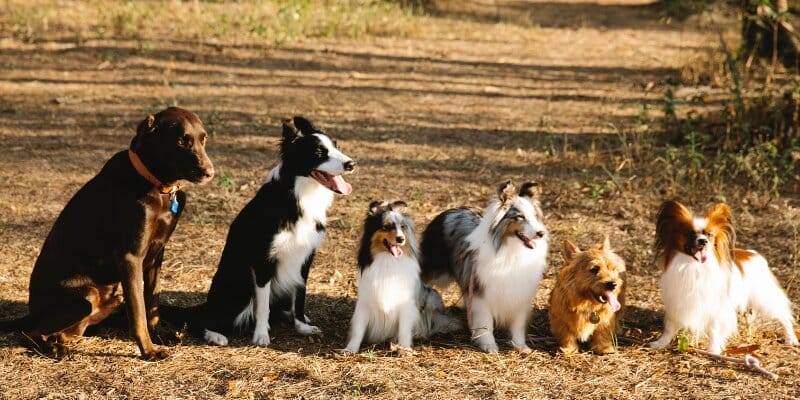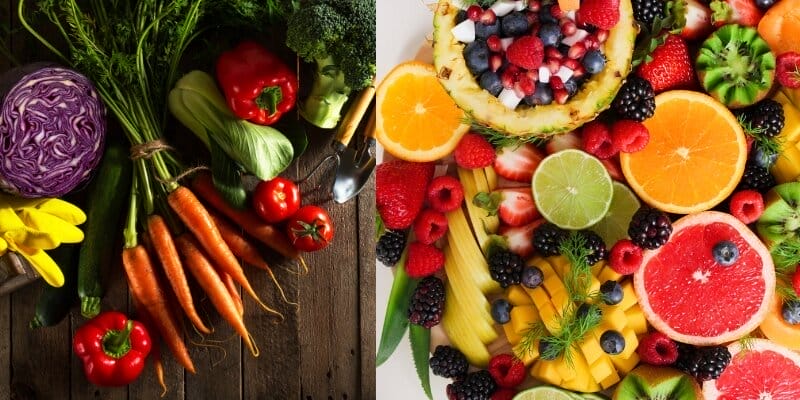Best Dog Food for Papillons 2023

Introduction: A Guide to the Best Dog Food for Papillons
Choosing the best dog food for Papillons is essential for their overall health and well-being. In this guide, we will explore the factors to consider when selecting the best dog food for Papillons and recommend some top choices. These charming and intelligent toy breed dogs deserve the best in terms of care, and that includes providing them with a well-balanced and nutritious diet.
Understanding the Papillon Diet
Papillons are known for their small size, high energy levels, and distinctively butterfly-shaped ears. These factors play a role in determining their dietary needs. A diet rich in protein, healthy fats, and essential nutrients is crucial for maintaining their energy levels, supporting their metabolism, and promoting a healthy coat.
What are the Best Dog Foods for Papillons?
Protein is Key:
Papillons, like many small dog breeds, benefit greatly from a diet with a high protein content. Look for dog food formulas where real meat, such as chicken, turkey, or fish, is listed as the main ingredient. Protein aids in muscle development, maintenance, and overall vitality.
Healthy Fats for a Lustrous Coat:
Papillons have a distinctive long, silky coat that requires special attention. Choose dog food that includes sources of healthy fats, such as omega-3 and omega-6 fatty acids. These nutrients contribute to a shiny and healthy coat while supporting skin health.
Mind the Portions:
Due to their small size, Papillons have smaller stomachs, and it’s crucial to provide them with appropriately sized portions. Look for dog food with serving recommendations tailored to small breeds. Avoid overfeeding to prevent obesity, which can lead to various health issues.
Avoid Fillers and Artificial Additives:
When selecting dog food for your Papillon, steer clear of formulas containing excessive fillers, artificial preservatives, colors, or flavors. Opt for natural ingredients that contribute to overall health without unnecessary additives that may cause sensitivities or allergies.
| Nutritional Aspect | Recommended | Examples |
| Protein | Real meat sources | Chicken, Turkey, Fish |
| Healthy Fats | Omega-3 & Omega-6 | Fish oil, Flaxseed, Chicken fat |
| Portion Size | Small Breed Portions | Royal Canin Papillon Adult Dry Food, Wellness CORE Small Breed Recipe |
| Avoid | Fillers & Additives | Artificial preservatives, excessive grains |
| Top Recommended Brands | Royal Canin, Wellness CORE, Blue Buffalo |
Best dog food for Papillons
- Royal Canin Papillon Adult Dry Dog Food:
- Specifically formulated for Papillons, taking into account their unique nutritional needs.
- Features a blend of nutrients to support skin and coat health.
- Tailored kibble size for the small jaw of Papillons.
- Wellness CORE Grain-Free Small Breed Turkey & Chicken Recipe:
- High-protein formula with real turkey and chicken.
- Grain-free for easy digestion.
- Includes antioxidants, probiotics, and omega fatty acids for overall health.
- Blue Buffalo Life Protection Formula Small Breed Adult Chicken & Brown Rice Recipe:
- Features real deboned chicken as the first ingredient.
- Includes wholesome grains for energy.
- Enhanced with Blue Buffalo’s exclusive Life Source Bits for immune system support.
How much should a papillon eat
Now we’ll explore the factors that influence how much should a Papillon eat and provide practical insights into maintaining a balanced diet.
Tailoring Portions to Size:
Papillons may be small, but their energy levels are anything but. The ideal portion size for a Papillon depends on factors such as age, weight, activity level, and metabolism. As a rule of thumb, opt for dog food formulated explicitly for small breeds and follow the recommended portion sizes on the packaging.
Age Matters:
Papillon puppies have different dietary needs than adult or senior Papillons. During the growth phase, puppies require more frequent meals with higher calorie content. As they transition to adulthood, adjusting the portion size to prevent overfeeding is crucial. For senior Papillons, whose metabolism may slow down, consider lower calorie options to maintain a healthy weight.
Activity Level and Lifestyle:
Consider your Papillon’s daily activities. If they are a bundle of energy, engaging in regular play and walks, they may require more calories than a less active companion. Adjust portion sizes based on their lifestyle to prevent under or overfeeding.
Monitor Body Condition:
A hands-on approach to monitoring your Papillon’s weight and body condition is invaluable. A healthy Papillon should have a visible waist when viewed from above, and you should be able to feel their ribs without excessive padding. If you notice weight gain or loss, adjust their portion sizes accordingly.
Quality Over Quantity:
The quality of the food matters just as much as the quantity. Opt for dog food with high-quality ingredients, real meat sources, and balanced nutrition. Premium dog food brands often provide feeding guidelines on the packaging to help you determine appropriate portions.
Treats and Snacks:
Treats are a delightful part of bonding with your Papillon, but moderation is key. Factor in treat calories when determining the daily food allowance to avoid unintentional overfeeding. Opt for healthy, dog-friendly treats to complement their diet.
Consult Your Veterinarian:
Every Papillon is unique, and individual factors such as health conditions may influence their dietary needs. Regular check-ups with a veterinarian can provide personalized guidance, ensuring your Papillon’s diet aligns with their specific requirements.
Papillon puppy feeding guide: what to feed papillon puppy
Ensuring the optimal growth and well-being of your Papillon puppy involves thoughtful feeding practices. Begin their journey with a puppy-specific, high-quality dog food featuring real meat as the main ingredient to provide the essential nutrients for their development. Prioritize quality over quantity, avoiding unnecessary fillers and additives. Due to their small size, offer smaller, more frequent meals initially, adjusting portions as your puppy grows.

- Introduce variety with wet puppy food and small amounts of fresh ingredients like cooked vegetables and lean meats.
- Be vigilant about harmful foods such as chocolate and onions.
- Transition to adult dog food gradually around the one-year mark.
- Maintaining routine veterinary check-ups to monitor their health and address any dietary concerns.
- Keep their thirst quenched with a constant supply of fresh water.
Feeding your Papillon puppy involves a balance of nutrition, care, and attention to their individual needs. With this guide, you’re well-equipped to navigate the rewarding journey of nourishing your Papillon puppy into a healthy and vibrant adult companion.
Papillion feeding chart
| 2-3 | 4 meals per day | 1/4 cup Puppy Food |
| 4-6 | 3 meals per day | 1/3 cup Puppy Food |
| 7-12 | 2-3 meals per day | 1/3 – 1/2 cup Puppy Food |
| 12-18 | 2 meals per day | 1/2 cup Adult Dog Food |
| 18+ | 2 meals per day | 1/2 – 3/4 cup Adult Dog Food |
Why Raw is the best food for your Papillons
Opting for a raw diet for your Papillon can be a great way to keep them healthy and happy. This type of diet is all about giving your dog uncooked meats, bones, and organs, which is similar to what dogs would eat in the wild. People who support raw feeding believe it’s better because it’s more natural for dogs. They say it can help with things like better digestion, a shinier coat, and more energy for Papillons.
Another plus is that raw diets often don’t include artificial stuff that can sometimes cause problems for dogs. But, it’s essential to be careful and talk to your vet before making the switch to make sure your Papillon gets all the right nutrients. Many Papillon owners who’ve tried raw feeding say their dogs seem to really love it and stay healthy, so it’s worth considering if you’re up for the challenge!
Biological Appropriateness:
The raw diet mirrors the natural, biologically appropriate eating habits of dogs’ ancestors in the wild. Comprising raw meat, bones, and organs, it seeks to provide the essential nutrients that dogs evolved to consume, promoting overall health and vitality.
Nutrient-Rich Goodness:
Raw diets emphasize real, unprocessed ingredients that pack a nutritional punch. The inclusion of raw meats, rich in proteins and amino acids, supports muscle development, energy levels, and a host of other bodily functions essential for a thriving Papillon.
Shiny Coats and Healthy Skin:
Advocates of raw feeding often rave about the positive impact on a dog’s coat and skin. The naturally occurring fats, such as omega-3 and omega-6 fatty acids found in raw meats, contribute to a lustrous coat and optimal skin health for our Papillon companions.
Improved Digestion and Dental Health:
Raw diets can enhance digestive health, as they are often easier for dogs to digest compared to highly processed commercial kibble. Additionally, chewing on raw bones can contribute to better dental health, helping to keep those small but mighty Papillon teeth clean.
Allergen Control and Fewer Fillers:
Raw feeding allows pet owners to have more control over what goes into their Papillon’s bowl, minimizing potential allergens and eliminating common fillers found in commercial dog food. This can be especially beneficial for dogs with sensitivities.
Individual Needs:
One of the standout features of raw feeding is the ability to tailor your Papillon’s diet to their individual needs. Adjustments can be made based on their age, weight, activity level, and any specific health concerns they may have.
Transitioning with Care:
While the benefits are compelling, transitioning to a raw diet should be done with care. It’s crucial to consult with a veterinarian to ensure a balanced nutritional profile and address any concerns or questions about making this dietary shift for your Papillon.
Fresh Food for Papillon

Veggies and Fruity Treats:
Incorporating a rainbow of vegetables and fruits can elevate your Papillon’s dining experience. Carrots, broccoli, blueberries, and apples are just a few examples of nutrient-rich additions that contribute to overall health and add a burst of flavor.
Careful Considerations:
While fresh food can be a delightful addition to your Papillon’s diet, it’s crucial to exercise caution. Some foods, such as onions, garlic, and certain fruits with pits, can be harmful to dogs. Always research and consult with your veterinarian to ensure that the fresh foods you introduce align with your Papillon’s well-being.
Transitioning to Fresh Food:
When introducing fresh food, it’s essential to do so gradually. A sudden change in diet can upset your Papillon’s stomach. Start by mixing small amounts of fresh food with their regular meals, gradually increasing the proportion over time.
Offering fresh food to your Papillon can be a fantastic way to provide them with a natural, nutrient-rich diet. With its potential to improve digestion, boost energy levels, and enhance overall health, fresh food stands as a compelling choice for many pet owners seeking the best for their Papillon companions. However, it’s essential to approach this dietary shift thoughtfully, seeking guidance from your vet and ensuring a balanced meal plan to support your Papillon’s health journey towards a vibrant and fulfilled life.
How much exercise does a papillon need
Ensuring your Papillon gets the right amount of exercise is key to keeping them happy and healthy. Despite their small size, Papillons are surprisingly energetic and agile. On average, they benefit from around 30 minutes to an hour of daily exercise, but individual needs may vary. This breed thrives on a mix of activities, including brisk walks, playtime, and even agility exercises that engage their intelligent minds.
Keep in mind that mental stimulation is equally important for Papillons, so incorporating puzzle toys or interactive games can contribute to their overall well-being. if they’re panting excessively or seem fatigued, it might be a sign to ease up. Finding the right balance of physical and mental stimulation ensures a content and well-exercised Papillon ready to snuggle up after a day of adventures.
Conclusion:
Selecting the Best dog food for Papillons involves careful consideration of their unique nutritional needs. Prioritize high-quality ingredients, appropriate protein levels, and essential nutrients to ensure your furry friend thrives. By choosing a well-balanced and nutritious diet, you are contributing to the overall health, energy, and happiness of your beloved Papillon companion.
Best Dog Food for Papillons
FAQs
Q: How much should Papillon eat?
A: Papillons typically require around 1/4 to 1/2 cup of high-quality dog food per day, split into two meals. Adjust based on factors like age, activity level, and individual needs.
Q: Do Papillons have sensitive stomachs?
A: Yes, Papillons can be prone to sensitive stomachs. It’s essential to choose dog food that is easily digestible and free from common allergens. Consult your vet if digestive issues arise.
Q: How much do Papillons weigh in kg?
A: Papillons are small dogs, weighing around 1.8 to 4.5 kg (4 to 10 pounds) on average. Individual weights may vary, so regular monitoring is advisable.
Q: What do Papillons need?
A: Papillons need a balanced diet with high-quality proteins, healthy fats, and essential nutrients. Regular exercise, mental stimulation, and affection are also crucial for their overall well-being.
Q: Can Papillon eat chicken?
A: Yes, Papillons can eat chicken as part of a balanced diet. Ensure it is cooked, boneless, and free from seasonings. Monitor for any signs of allergies or sensitivities.
Q: Do Papillons sleep a lot?
A: Papillons are known for their bursts of energy but may sleep around 12 to 16 hours a day, including naps. Adequate rest is essential for their overall health and vitality.
Q: What should be the main ingredient in Papillon dog food?
A: Look for dog foods with real meat as the main ingredient. Quality proteins like chicken, turkey, or fish support Papillons’ muscle development and overall health.
Q: How much should I feed my Papillon?
A: Papillons typically require 1/4 to 1/2 cup of high-quality dog food per day, split into two meals. Adjust based on their age, activity level, and individual needs.
Q: Are there specific nutrients crucial for Papillons?
A: Yes, prioritize dog foods rich in omega-3 and omega-6 fatty acids for a healthy coat. Ensure a balanced diet with essential vitamins and minerals to support their overall well-being.
Q: Should I choose grain-free dog food for my Papillon?
A: While grain-free options can be suitable, focus on high-quality ingredients. Some grains can provide beneficial nutrients, so it’s more about the overall quality of the food.
Q: Are there dog food brands tailored for Papillons?
A: Yes, some brands, like Royal Canin, offer formulations specifically designed for Papillons, considering their unique nutritional needs and smaller jaw structure.
Q: Can I give homemade food to my Papillon?
A: It’s possible, but consult with your veterinarian to ensure the homemade diet is nutritionally balanced. Homemade meals may lack essential nutrients, so supplements might be necessary.
Q: How can I prevent overfeeding my Papillon?
A: Follow recommended portion sizes based on your dog’s weight and activity level. Regularly monitor their body condition and adjust portions accordingly to maintain a healthy weight.
Q: Should I consider a raw diet for my Papillon?
A: A raw diet can be an option, but it requires careful planning. Consult your vet to ensure it’s nutritionally balanced and safe, taking into account your Papillon’s specific health needs.
Q: Are there signs my Papillon is allergic to their food?
A: Watch for signs like itching, gastrointestinal upset, or changes in coat quality. If you suspect allergies, consult your vet to determine the cause and adjust their diet if needed.
Q: Can I switch my Papillon’s food abruptly?
A: It’s best to transition gradually over 7-10 days to avoid digestive upset. Mix the new and old food in varying proportions until fully transitioning to the new diet.
AUTHOR : ANAM AHMED






